| |||||
| Decades: | |||||
|---|---|---|---|---|---|
| See also: | Other events of 1960 Timeline of Ethiopian history | ||||
The following lists events that happened during 1960 in Ethiopia .
| |||||
| Decades: | |||||
|---|---|---|---|---|---|
| See also: | Other events of 1960 Timeline of Ethiopian history | ||||
The following lists events that happened during 1960 in Ethiopia .

Haile Selassie I was Emperor of Ethiopia from 1930 to 1974. He rose to power as Regent Plenipotentiary of Ethiopia (Enderase) for Empress Zewditu from 1916. Haile Selassie is widely considered a defining figure in modern Ethiopian history, and the key figure of Rastafari, a religious movement in Jamaica that emerged shortly after he became emperor in the 1930s. He was a member of the Solomonic dynasty, which claims to trace lineage to Emperor Menelik I, believed to be the son of King Solomon and Makeda the Queen of Sheba.
The Battle of Maychew was the last major battle fought on the northern front during the Second Italo-Abyssinian War. The battle consisted of a failed counterattack by the Ethiopian forces under Emperor Haile Selassie making frontal assaults against prepared Italian defensive positions under the command of Marshal Pietro Badoglio. The battle was fought near Maychew, Ethiopia, in the modern region of Tigray.

The emperor of Ethiopia, also known as the Atse, was the hereditary ruler of the Ethiopian Empire, from at least the 13th century until the abolition of the monarchy in 1975. The emperor was the head of state and head of government, with ultimate executive, judicial and legislative power in that country. A National Geographic article from 1965 called imperial Ethiopia "nominally a constitutional monarchy; in fact [it was] a benevolent autocracy".

Aman Mikael Andom was an Ethiopian general of Eritrean origin, and the first post-imperial acting head of state of Ethiopia. Aman was also the first Chairman of the Derg. He was appointed to this position following the coup d'état that ousted Emperor Haile Selassie on 12 September 1974, and served until his death in a shootout with his former supporters.

Amha Selassie was Emperor-in-exile of Ethiopia. As son of Haile Selassie I, he was Crown Prince and was proclaimed monarch three times. He was first proclaimed Emperor during an unsuccessful coup attempt against his father in December 1960, during which he alleged that he was detained and compelled to accept the title. After his father was deposed in a later coup, he was proclaimed King in absentia by the Derg on 12 September 1974 in an act which he never accepted as legitimate and that ended in the abolition of the Ethiopian monarchy on 21 March 1975. He was again proclaimed Emperor in exile on 8 April 1989. This time he sanctioned the proclamation and accepted its legitimacy. After his accession, his full reign name was His Imperial Majesty Emperor Amha Selassie I, Elect of God, Conquering Lion of the Tribe of Judah and King of Kings of Ethiopia.
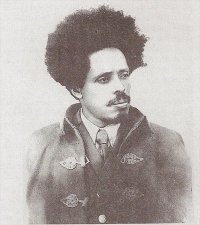
RasAbebe Aregai was a military commander who served as Prime Minister of Ethiopia from 27 November 1957 until his death. He was a victim of the unsuccessful 1960 Ethiopian coup.

The Solomonic dynasty, also known as the House of Solomon, was the ruling dynasty of the Ethiopian Empire from the thirteenth to twentieth centuries. The dynasty was founded by Yekuno Amlak, who overthrew the Zagwe dynasty in 1270. His successors claimed he was descended from the legendary king Menelik I, the supposed son of the biblical King Solomon and the Queen of Sheba, in order to legitimize the dynasty's assumption of power. Although this claimed ancestry gave the dynasty its name, there is no credible evidence that the dynasty was descended from Soloman or the Davidic line. The Solomonic dynasty remained in power until 1974, when its last emperor Haile Selassie was overthrown by a coup d'état.

RasDesta Damtew was an Ethiopian noble, an army commander, and a son-in-law of Emperor Haile Selassie I. He is known for his leadership in the Ethopian Army during the Second Italo-Ethiopian War. He was executed on February 24, 1937 by the Italian Armed Forces shortly after Ethiopia's loss in the war.

Kebur Zabagna or Zebenya was the Ethiopian imperial guard. Also known as the First Division, this unit served the dual purposes of providing security for the Emperor of Ethiopia, and being an elite infantry division. It was not, however, part of the organizational structure of the Ethiopian regular army as it was part of the Zebagna, the Addis Ababa Guard. The Kebur Zabagna was based at Addis Ababa.

The Ethiopian Empire, also formerly known by the exonym Abyssinia, or just simply known as Ethiopia, was an empire that historically spanned the geographical area of present-day Ethiopia and Eritrea from the establishment of the Solomonic dynasty by Yekuno Amlak approximately in 1270 until the 1974 coup d'etat of Emperor Haile Selassie by the Derg. By 1896, the Empire incorporated other regions such as Hararghe, Gurage and Wolayita, and saw its largest expansion with the federation of Eritrea in 1952. Throughout much of its existence, it was surrounded by hostile forces in the African Horn; however, it managed to develop and preserve a kingdom based on its ancient form of Christianity.

Mengistu Neway was an Ethiopian commander of the Imperial Guard during the reign of Emperor Haile Selassie. He is noted for being one of the early dissidents of the Emperor's regime and for organizing the 1960 coup attempt with his younger brother Germame Neway, for which he was sentenced to death.
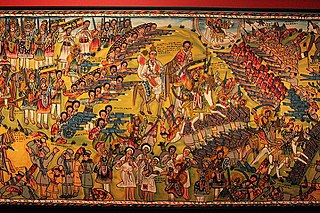
The Army of the Ethiopian Empire was the principal land warfare force of the Ethiopian Empire and had naval and air force branches in the 20th century. The organization existed in multiple forms throughout the history of the Ethiopian Empire from its foundation in 1270 by Emperor Yekuno Amlak, to the overthrow of the monarchy and Emperor Haile Selassie in 1974 by members of the Ethiopian army. Due to the country's position along multiple trade routes and its maintenance of independence against multiple Islamic and colonialist invasions lead to multiple conflicts against numerous major countries including the Ottomans, Egyptians, British, and Italians.

The March of the Iron Will was an Italian Fascist propaganda event staged from 26 April to 5 May 1936, during the final days of the Second Italo-Ethiopian War. Its goal was to capture the Ethiopian capital, Addis Ababa in a show of force. An Italian mechanized column under the command of Pietro Badoglio, Marshal of Italy, advanced from the town of Dessie to take Addis Ababa. The march covered a distance of approximately 200 miles (320 km).
De Bono's invasion of Ethiopia took place during the opening stages of the Second Italo-Ethiopian War. Italian General Emilio De Bono invaded northern Ethiopia from staging areas in the Italian colony of Eritrea on what was known as the "northern front".

Seyoum Mengesha KBE was an army commander and a member of the royal family of the Ethiopian Empire.
Fikremariam was an Ethiopian commander and a patriot.
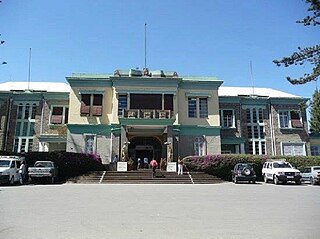
The 1960 Ethiopian coup d'etat attempt was an attempted coup d'etat and a series of shootouts in the Ethiopian Empire on 13 December 1960 against Emperor Haile Selassie. The Council of the Revolution, four conspirators led by brothers Germame Neway and Brigadier General Mengistu Neway, commander of the Kebur Zabagna, sought to overthrow the Emperor during a state visit to Brazil in order to install a progressive government. The coup leaders declared the beginning of a new government under the rule of Haile Selassie's eldest son, Crown Prince Asfaw Wossen, that would address the numerous economic and social problems Ethiopia faced. The Council gained control of most of the capital city, Addis Ababa, and took several ministers and other important people hostage. After its initial success, the majority of the military and populace quickly aligned against the coup, and by 17 December loyalists had regained control of Addis Ababa. At least 300 people were killed during the coup, including most of the conspirators.
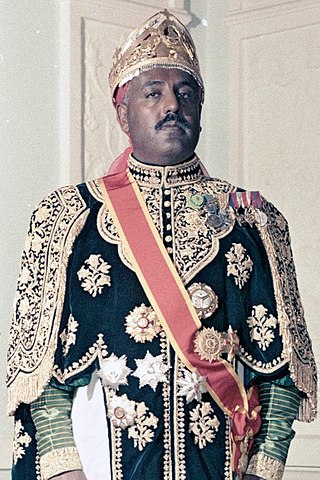
LeulRasAserate KassaGCVO was a Viceroy of Eritrea and a member of the nobility of the Ethiopian Empire. He was the fourth son of Ras Kassa Haile Darge, and his wife Princess (Le'ilt) Tsige Mariam Beshah. Prince Aserate Kassa was educated at Monkton Combe School in the United Kingdom between 1937 and 1938. He was married to (Le'ilt) Zuriashwork Gebre-Igziabiher, daughter of Jantirar Gebre-Igziabiher, and granddaughter of Empress Menen Asfaw, consort of Emperor Haile Selassie I. Prince Aserate Kassa was the head of the Selalle sub-branch of the Shewan branch of Ethiopia's Imperial Solomonic dynasty.
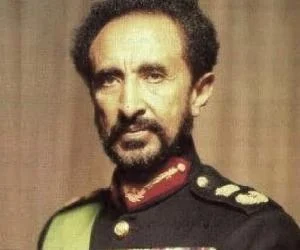
Opposition to Haile Selassie relied largely of internal administration of his country. While Haile Selassie made attempt to modernize the country and brought to global power since Italy's occupation in 1936–41, the later administration met with negative public attitude especially among educated people in universities and peasants.

On 12 September 1974, Emperor Haile Selassie was deposed by the Coordinating Committee of the Armed Forces, Police, and Territorial Army, a Soviet-backed military junta that consequently ruled Ethiopia as the Derg until 1991.